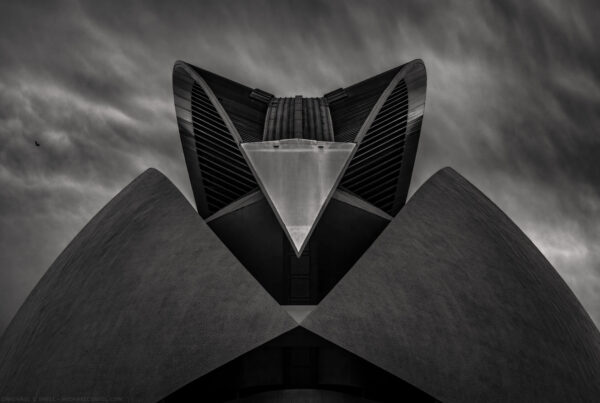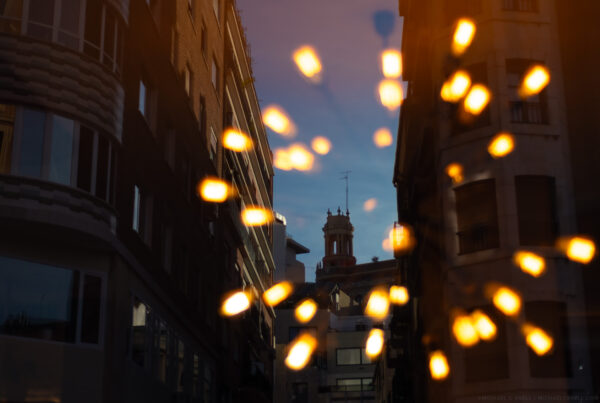It’s now 2022 and the start of our third year of the Covid pandemic. I’ve been looking back at 2020 and 2021 and realizing just how much my career has changed. I’ve considered myself primarily a “travel photographer” for the last 15 to 20 years but, for the last two years, my role as “travel photographer” has existed only through my licensing of stock images that I created before the pandemic reared its head.
That’s not to say that I haven’t photographed anything in 2020 or 2021 — I have — it’s just not been in the travel genre. I’ve done much more studio and portrait work in the past two years than ever before and I feel I will be a better, more rounded photographer going forward, when I can get back on the road to shoot travel. But that story is for another day.
Has the pandemic created a renewed need for stock travel photography?

Two of the many images I licensed through stock agencies during the past two pandemic years. The shot of the Festival of San Fermin in Pamplona, Spain, could not have been made on assignment during the past two years, due to the pandemic closures and cancellations. I have to wonder how many of my stock sales the past two years have come from necessity, when assigned photography has just not been an option.

Today I want to look at stock photography.
The kind of stock photography I do, and that I’m talking about here, is not the mass-produced lifestyle and office-setting stock imagery that many first think of when they hear the term “stock photography.” In the travel and landscape stock realm, images are most desirable if they take advantage of unique conditions, events, weather, etc., that would be hard to replicate during a short turn-around assignment. If it’s October and your magazine needs a shot of an annual Holiday light display that won’t be up until mid-December, you’ll need to look for a stock shot, unless you had the foresight to assign the shoot a year earlier. Shots that need to feature a season other than the current season are also great for stock. I remember, years ago, being assigned to photograph a story on a small town main street in October for a Spring magazine issue. I was told to “try and make it look Spring-y” even though every shop window was decorated for Halloween and the trees were already in Fall color.
Stock photography has been hurt by industry changes and pricing models that have been particularly damaging to the kind of stock I shoot. I myself didn’t enter the stock industry until the fall had already begun. I missed the golden age when prices made it possible to build an entire career on travel stock, but I did get in before the second fall. I was seeing pretty decent pricing during my first few years in the industry, before digital and $1 royalty free pricing models did their real damage. My average per-image sale price has fallen over the past 15 years by roughly 85%. What once would have been a $1,000 license is now more like $150 — and even those sales are becoming rare as I see reports of my images only earning me a few cents on some licenses.
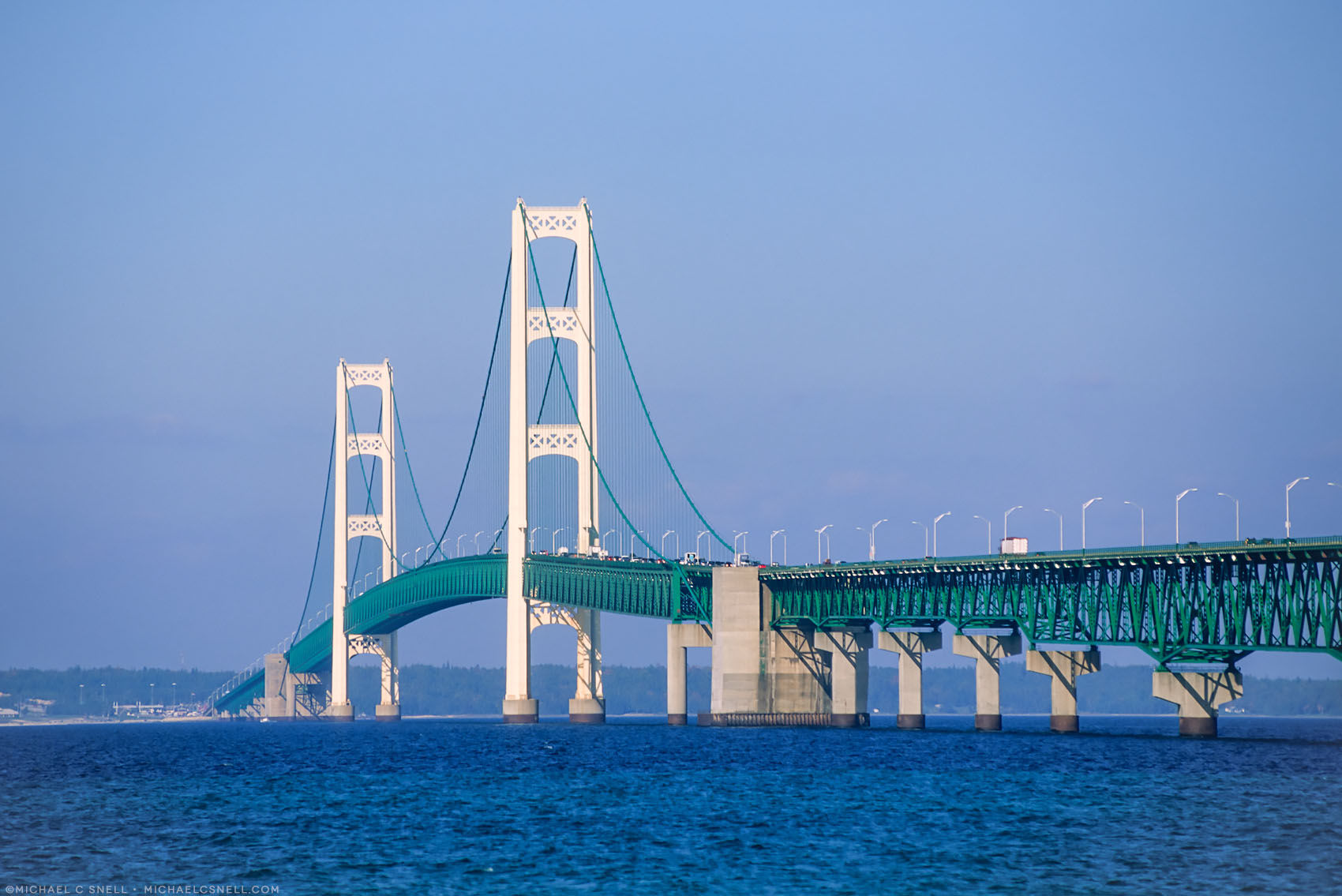
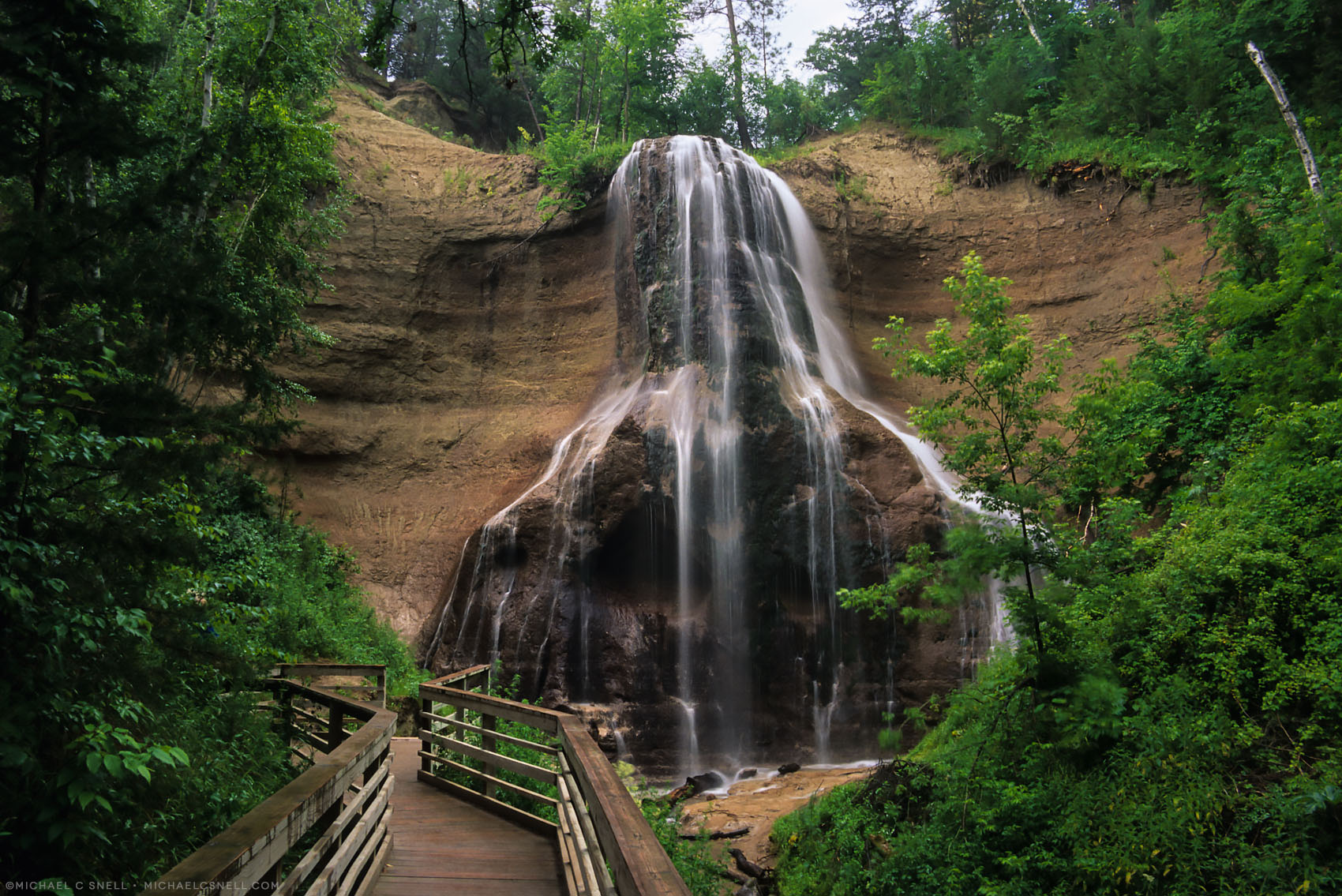
Some images can have a long shelf-life, at least, allowing them to earn decent amounts over time and repeated licensing. These two images — the bridge in Michigan and the Nebraska waterfall — are just a couple of the 35mm transparency files that still live in my stock libraries. Shots like these without a lot of people, cars, signage, etc., are more timeless and can sell for years. There’s no outdated fashion or technology to give away their age.
So I’ve been seeing this slide in stock photo pricing for several years. Many of my friends have abandoned stock altogether, as prices are in many cases getting so low that the effort of listing and keywording images isn’t worthwhile. But, I’ve stuck with stock — just to see how things shake out. I don’t invest as much time in prepping new photos as I used to, but I keep my international work up-to-date, and leave older images in the libraries since the effort of listing them is already in the past.
When the pandemic hit and I realized it was going to be a while before many of us could be making new travel images again, I hoped stock might see some resurgence. Not only did the pandemic make it hard to actually get to a location to shoot an assignment, but most destinations have implemented policies and altered their built environment in ways that will make any current images look very much “of this time.” Think of all the restaurants that have added temporary (often crudely built) outdoor seating, limited spaced-out seating indoors, added plexiglass shields in front of reception and checkout areas, etc.
I should point out that I’m all for these safety measures. I’m in favor of masks, vaccines, and anything else that will help keep the spread of Covid down. I’m merely speaking about the physical signs of the pandemic fight that impact a photographer’s ability to make timeless images. Images that won’t immediately be perceived in 15 years as having come from 2020 because everyone in the shot is wearing a mask.
On the other hand, there are photo journalistic stories about the pandemic that need to show this aspect of our daily lives at this point in time. Those stories are — I imagine — still being assigned, but when it comes to stock usage where a timeless image will have years to generate income, those shots are going to have less on-going value.
In 2020, I still saw my stock sales drop and I feared I might be wrong about a pandemic-bump for the stock photo industry, but in 2021 I have seen some signs of a bounce. I don’t have a full year of reporting from all of my agencies yet, but looking at Alamy alone, I’m seeing an increase in licenses back to what was more the norm 5 or 6 years ago. The price-per-image has remained flat — at least it hasn’t fallen further — but more sales at the same price is still a gain. And this is without me adding any new images to Alamy in the last two years.
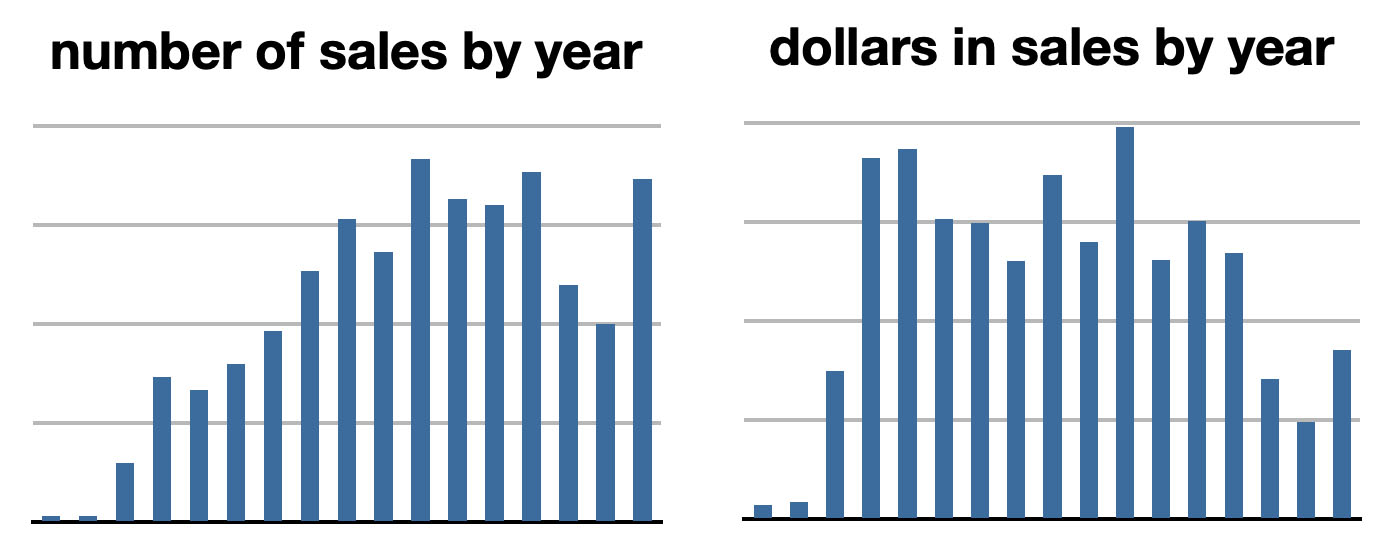
These charts show my 17 years with Alamy, with 2021 being the far-righthand bars. It’s hard to draw any conclusions by anything here other than the last two to three years because my number of images listed with Alamy changed radically throughout this time, and prices were dropping. But you can see an overall trend of sales increasing, without the income really increasing, and then a drop in sales and prices in the last few years. The uptick in sales in 2021 may just be an outlier, or maybe it’s the beginning of a resurgence in interest in stock travel images.
Is travel stock on the rebound? Maybe briefly, but I doubt we’ll ever see the licensing fees get back up to where they should be (or where we’d like them to be).
I think stock will always remain a sideline for me. I like giving older images a chance at new life, and I always make sure my assignments allow me to retain all rights to my photos. There’s often a period of time that I’m not allowed to market assignment images, to give the initial publication the ability to use the images first, but by keeping the rights and marketing the images as stock later allows me to continue to generate a little income from the shoot. However small that may be. I’ll even be more interested in taking a lower-paying assignment, if I think it might gain me some useful stock down the road.

Images like this one of Tutankhamun’s golden mask at the old Egyptian Museum in Cairo may have become desirable as the opening of a new Grand Egyptian Museum in Giza approaches.

Detail shots like this fossil are also good sellers, often for textbooks. This shot was taken at Miguasha National Park on the Gaspe peninsula in the province of Quebec, Canada
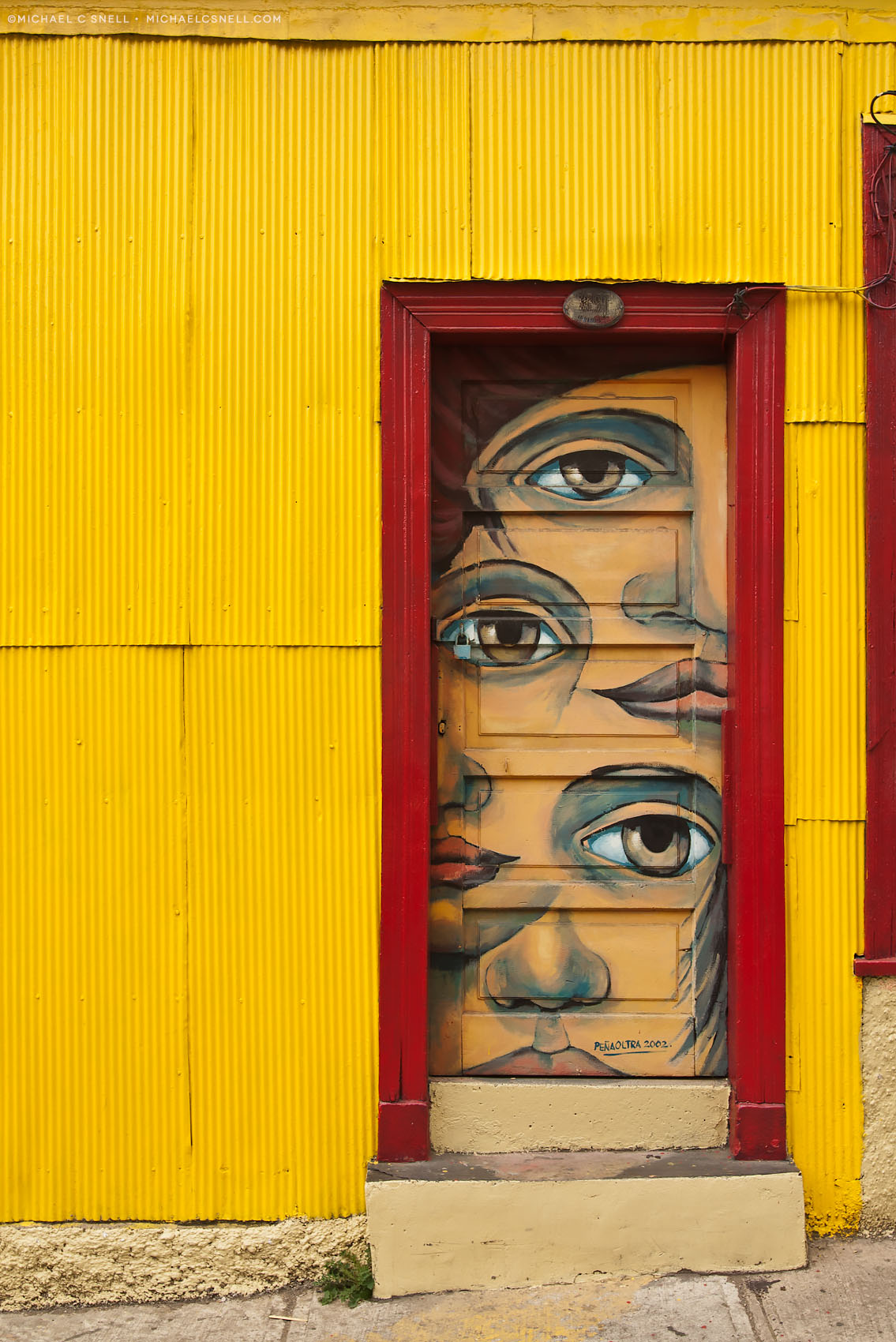
I’m always surprised to see how many of my images from Chile end up on my sales reports each quarter. Considering how few days I’ve actually spent photographing in Chile, that country has long been one of my best sellers. I shot this colorful door in Valparaiso 15 years ago now, and it continues to appear in nearly every report — often selling as personal prints for decor.
The following chart shows my distribution of sales by country — the photo location, not the location of the buyer. Early on, the US accounted for well over 50% of all of my sales, but as stock pricing fell I have spent less time uploading domestic images. I do still upload images from all of my international trips, so those numbers are gradually taking over. Spain has recently overtaken Canada as my second most-sold country. The smaller charts on the right break my sales down between those listed with Robert Harding World Imagery (top) and Alamy (bottom). Alamy has a much larger percentage of sales for US destinations, but that’s because I have far more US images listed with them than with Robert Harding.
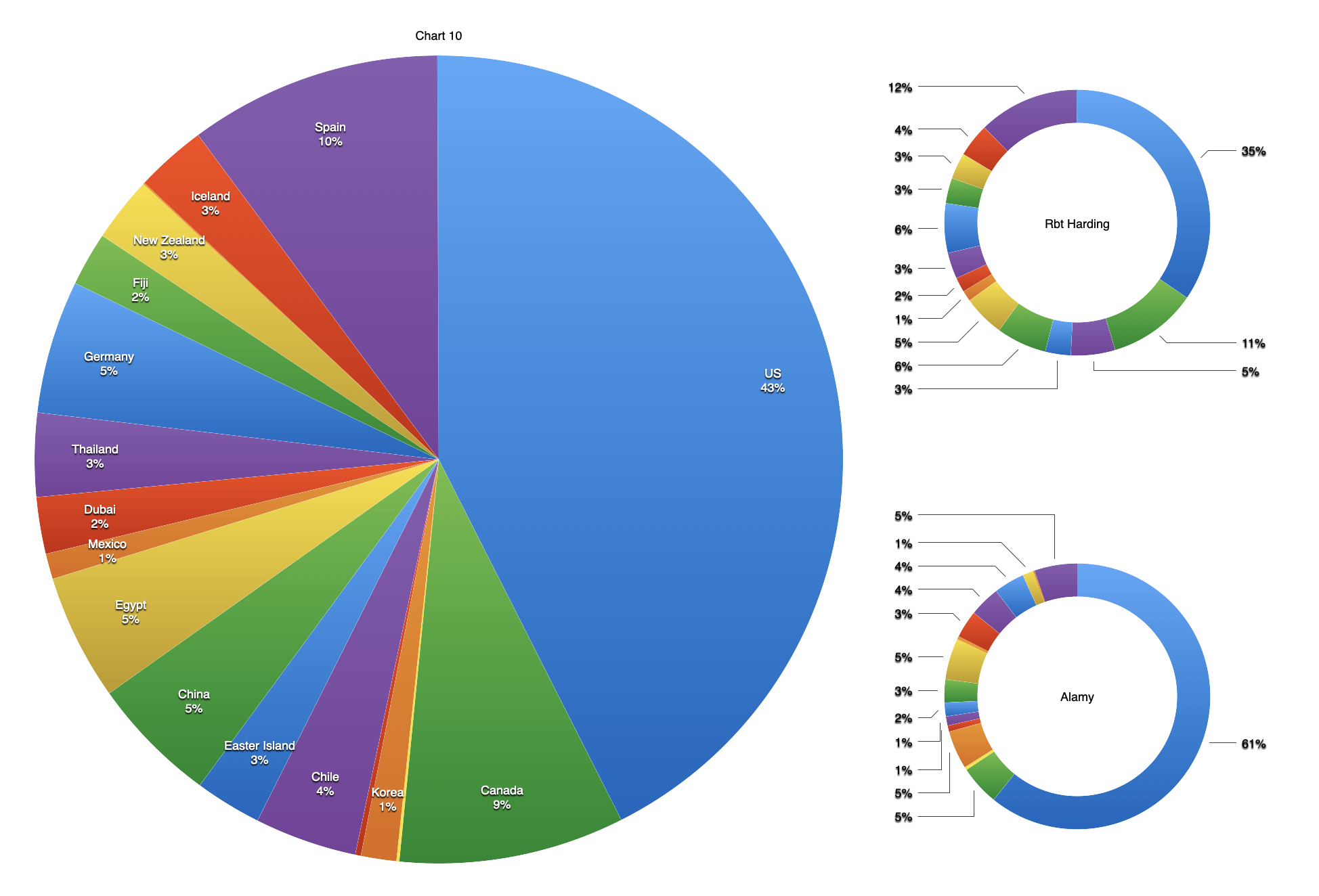

It’s funny how there are moments that consist of maybe 30 minutes, when everything comes together and you are able to make a whole suite of images that continue to sell over and over and over again. This particular evening in Perce, Canada, was like that. I had decided to walk down to Perce Rock just before sunset to see if I could find a photo or two looking across the the causeway to the rock itself, as it was bathed in orange light. I shot, and shot, and shot, and to this day, it is rare for me to get a stock sales report that doesn’t have one of those images listed. Other times, I’ll toil away for a week in some location and I’ll struggle to get a few images placed through stock agencies. It’s those magical moments that really pay off in the long run. If only there were a way to predict when they’ll happen. All I can say about that is, it’s best to be out there shooting when those stars align. If you’re home on the couch, it will be someone else’s magical moment.

One more shot from this past year’s sales report — an image of the bar area of the Parador de Carmona in Spain. I am so ready to be back in places like this, enjoying other cultures, meeting and talking with locals and fellow travelers. I feel I took it all for granted before the pandemic, but now I’m ready to appreciate things on a whole new level. Soon, I hope.
For anyone that’s interested to see what I have listed with Robert Harding World Images and Alamy, you can follow these two links to go directly to my galleries.
My photos on Robert Harding World Images
Here’s hoping we can all get back out there soon to start making some new photos and memories. I know it’s possible to go many places again already but, for professional travel, I’m still waiting a bit. I not only want to be able to make the trip (and make it home) with no, or few, worries, but I want to be able to once again find those timeless images. Photos that won’t look dated in two years, or five, or ten. To be honest, I hope photos of masses of people in masks, socially distancing themselves, do look dated — very soon. I’m ready for us all to get back to some semblance of normality. In the meantime, stay safe and let’s try to be kind to one another. See you on the road again one day.
